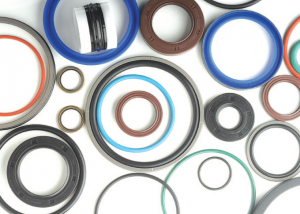Sealing rings and oil seals are available in various standard and specialized materials for the sealing lip (the elastomer component), the metal insert, and the spring. Usually, the material used for the sealing lip is specified. The description of elastomer materials follows the nomenclature used in DIN ISO 1629 and ASTM D 1418. The raw material for the elastomer element is synthetic rubber produced by the chemical industry. Elastomers differ based on the base polymer from which they are made.
The finished material used to produce the elastomer for the oil seal is obtained by combining the raw material, rubber, with numerous additives, such as fillers, pigments, plasticizers, processing aids, antioxidants, vulcanizing agents, curing accelerators, retarders, and more. This process provides the specific characteristics required for the material.
Sealing rings are available on the market in both standard materials suitable for a wide range of applications and specialized materials for applications requiring very high performance. The sealing ring achieves its final shape through a vulcanization process, during which the metal insert is securely bonded to the rubber. Following a chemical-physical transformation, the rubber transitions from a predominantly plastic state to an elastic state, acquiring its sealing properties. This is achieved either through a cutting operation afterward or directly during the molding process. The spring is inserted at the end of the process.
Let’s take a closer look at the various standard and specialized materials available for the sealing lip:
Nitrile Rubber (NBR)
NBR oil seals are made using a copolymer elastomer of butadiene and acrylonitrile, and they are used for most conventional fluid sealing applications. The acrylonitrile content determines the classification into low, medium, or high nitrile. The higher the content, the greater the resistance to oils and petroleum-derived hydrocarbons. However, this also decreases flexibility at low temperatures. For this reason, the standard NBR compound used offers the best compromise between oil and hydrocarbon resistance, flexibility, and mechanical strength.
- Operating temperature: -30°C to 100°C (120°C for high-nitrile classification)
- Color: Black
Advantages:
- Good resistance to mineral oils and greases
- Good resistance to water and radiator fluids
- Good tear and abrasion resistance
- Good flexibility
Limitations:
- Poor resistance to ozone, weather, and direct sunlight
- Not resistant to glycol-based fluids
- Poor resistance to polar fluids (ketones, ethers, esters), chlorinated hydrocarbons, and aromatic solvents
Fluorinated Rubber (FPM)
Better known as Viton® (a trademark of DuPont), its primary advantage lies in its resistance to high temperatures. Viton oil seals are usually brown in color.
- Operating temperature: -30°C to 200°C
- Color: Brown
Advantages:
- Excellent resistance to mineral oils and greases, including most additives, and hydrocarbons
- Resistant to most chemicals, except ketones, ethers, and esters
- Excellent resistance to aging, ozone, and weather
Limitations:
- Hardens at low temperatures
- Lower abrasion resistance compared to NBR compounds
Silicone Rubber (SIL)
Also known as MVQ or VMQ, its main advantage is its relative stability across a wide temperature range. Silicone oil seals and sealing rings are available upon request.
- Operating temperature: -60°C to 200°C
- Color: Red
Advantages:
- Stability across temperature variations
- Good resistance to mineral oils and greases
- Excellent resistance to aging, ozone, and weather
- Good chemical resistance to alkalis
Limitations:
- Not recommended for use with hydrocarbons containing benzene or paraffin and light mineral oils
- Poor resistance to water, acids, and non-mineral brake fluids
- Low tensile strength and abrasion resistance
Ethylene Propylene Rubber (EPDM)
Characterized by high resistance to abrasion, aging, and weather, this compound is specifically used where moderate operating temperature ranges are required.
- Operating temperature: -50°C to 150°C
- Color: Black
Advantages:
- Resistant to non-mineral oils, brake fluids
- Resistant to polar fluids, aging, and water
Limitations:
- Poor resistance to mineral oils and greases
Polyurethane
This elastomer is distinguished by exceptional abrasion resistance—better than all other rubbers—as well as high strength and tear resistance while maintaining excellent flexibility at low temperatures.
- Operating temperature: -40°C to 100°C
Advantages:
- High mechanical strength
- Good flexibility
- Excellent abrasion resistance
- Good resistance to petroleum and derivatives, weather, and ozone
Limitations:
- Poor resistance to aqueous, acidic, or alkaline solutions, hot water, glycol, steam, and ketones
- Rapid degradation at high temperatures

